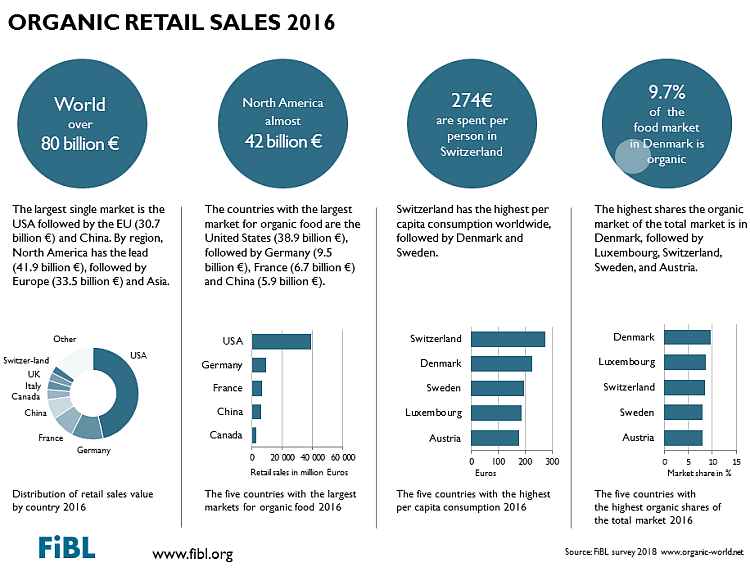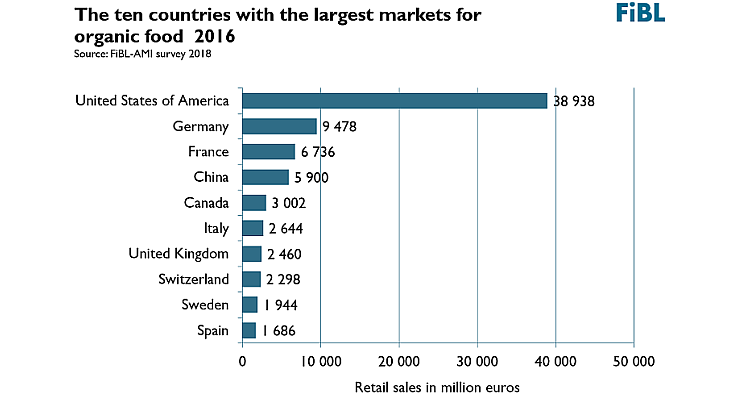◊ By Karin Heinze; Graphics © FiBL/AMI*
More farmers, more land and a growing market. This is the résumé of the 19th edition of The World of Organic Agriculture. The Research Institute of Organic Agriculture (FiBL) and IFOAM – Organics International launched the statistical yearbook at Biofach 2018 in Nuremberg. This comprehensive collection of the latest available data (2016) on organic agriculture worldwide contains data on area, operators, and retail sales: 57.8 mn ha of organic agricultural land and organic products, with a total value of almost US$ 90 bn were sold globally.

The distribution of retail sales value shows North America and Europe contribute to 90% of global organic retail sales
POSITIVE TREND CONTINUES
Consumer demand is increasing and 178 countries report organic farming activities. The yearbook provides a clear statement on the resilience of the organic market trend. “Considering the latest figures and the continuous and sustainable growth over many years, the organic movement can look confidently to the future,” summarise the Swiss State Secretariat for Economic Affairs (SECO) and the International Trade Centre (ITC) supporters of the The World of Organic Agriculture, in their foreword.
GLOBAL ORGANIC SALES REACHED US$ 90 BN
The market research company Ecovia Intelligence (formerly Organic Monitor) estimates the global market for organic food to have reached US$ 89.7 bn in 2016 (more than EUR 80 bn). In detail the data shows that the United States continues to be the leading market, with EUR 38.9 bn whereas in 2015 it was EUR 35.9 bn, followed by Germany with EUR 9.5 bn (2015: EUR 8.6 bn), France with EUR 6.7 bn (2015: EUR 5.5 bn), and China with EUR 5.9 bn (2015: EUR 4.7 bn).
Furthermore, most of the major markets continued to show double-digit growth rates in 2016. The organic market in France grew by 22%. The highest per capita spending was in Switzerland (EUR 274), and Denmark had the highest organic market share (9.7% of the total food market).
ALMOST 3 MN PRODUCERS WORLDWIDE ACROSS 60 MN HECTARES
On the producer side, the statistical yearbook registered 2.7 mn organic producers worldwide—a growth of 300,000 new producers in comparison to 2.4 mn in 2015. India continues to be the country with the highest number of producers (835,200), followed by Uganda (210,352), and Mexico (210,000).
Together with the growth of farmers, the organic farmland has increased by 15% to almost 60 mn ha. According to The World of Organic Agriculture yearbook, a total of 57.8 mn ha were organically managed at the end of 2016, representing a growth of 7.5 mn ha over 2015, the largest growth ever recorded.
Australia is the country with the largest organic agricultural area (27.2 mn ha), followed by Argentina (3 mn ha), and China (2.3 mn ha). Almost half of the global organic agricultural land is in Oceania (27.3 mn ha), followed by Europe (23%; 13.5 mn ha), and Latin America (12%; 7.1 mn ha). In 15 countries, 10% or more of all agricultural land is organic, another new record in global organic statistics.
* Agricultural Market Information Company, Germany
The author is editor of www.bio-markt.info (German) and www.organic-market.info (English), online magazines for organic trade



ORGANIC FOOD MARKET IN EU
Super